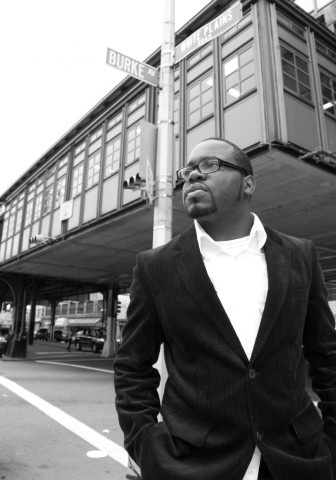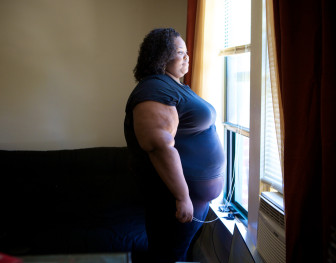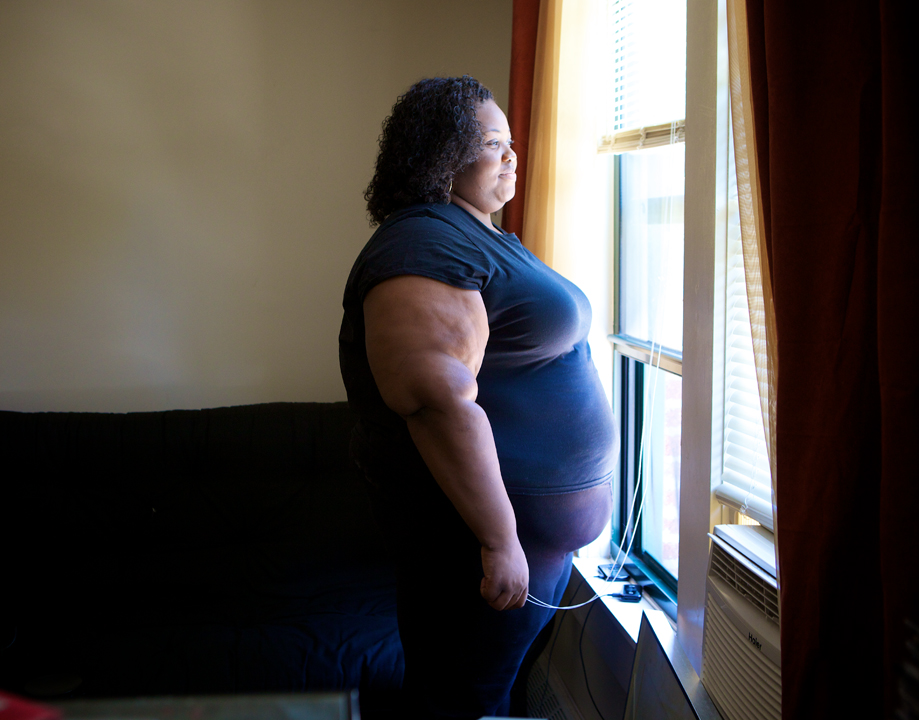
Jim Sewastynowicz
Richard Wilkerson, 27, of Bronx, NY, aged out of the foster care system at the age of 18, and in his own words wasn't ready for living on his own. After living for two years with a woman, whom he calls "Mom", he has been living on his own for five years, volunteers at the Beth Abraham Nursing Center and signs with his church's mens choir.
Richard Wilkerson needs two hands to count the number of families he had as a boy.
On a recent, unusually temperate summer morning, Wilkerson, 28, sat at a picnic table in the courtyard of the Long Island Children’s Museum and counted them off. All around him children scampered and squealed, shepherded around by attentive parents and summer camp counselors.
 There were his grandparents and the long trips from Hollis, Queens to upstate New York when he would stare out the bus window, a city kid dazzled by all that space, on his way to visit his mother in prison. Years later, there was a stint with his mother after she was released that involved a trip to a crack house that ended abruptly when he tripped on an uneven plank in the floor and was sent home bleeding. And the group homes, one in the Bronx, another in Manhattan. And there were the foster families.
There were his grandparents and the long trips from Hollis, Queens to upstate New York when he would stare out the bus window, a city kid dazzled by all that space, on his way to visit his mother in prison. Years later, there was a stint with his mother after she was released that involved a trip to a crack house that ended abruptly when he tripped on an uneven plank in the floor and was sent home bleeding. And the group homes, one in the Bronx, another in Manhattan. And there were the foster families.
And then, late in his foster life, he met a woman he could call mom who gave him a place to retire his “get ready bag.”
Wilkerson said he found out who his ‘real’ mother was on his birthday. Her name is Mary Chancie, 50, and she still has a room for Wilkerson whenever he needs it. With all his travails, Wilkerson says, he is lucky. Most of his confederates in the foster care system in New York and around the country don’t have anyone to count on after aging out.
Wilkerson’s story is one of 15 told through pictures hanging on two bright orange walls inside theLong Island Children’s Museum as part of an exhibit called “Everybody Needs Someone: The Aging Out of Foster Care Project” on display until Sept. 2. The title describes the abrupt transition children who age out of the foster care system go through when they turn 21; when they stop being wards of the state -- effectively the children of a community become the children of no one with the strike of a clock.
At 21, foster kids are on their own.
Aging Out, In Photos

William Vazquez
Brittny Bodden, 22, of Long Island, NY, lived with her grandmother before going into foster care, and then lived in many different homes as she grew up. She was homeless for a while, but now has a place to live and is going to college. Brittny wants to become a social worker and help kids who are growing up like she did. She graduated in the Spring of 2012 from college in Long Island.
Both walls of the exhibit feature a mix of portraits and documentary photographs chronicling the lives of former foster children from the greater New York area; one is dedicated for those who aged out into a family, like Wilkerson, the other is for children who were left to fend for themselves, like Brittny Bodden, 23.
“I don’t think anything can prepare you for what happens when you age out,” said Bodden, who was homeless for a stretch after leaving the system.
The exhibit, a sometimes bleak look at life on the desperate fringes of society, is incongruously sandwiched between the “Framed” portion of the museum where children are scribbling on photocopies of the Mona Lisa, and the “Toolbox” section where visitors get hands on with machines.
Stenciled on the wall above a dusty black canvas duffle bag is a question: “If you had to move to a new home today what would you pack in your bag?” The “get ready bag” is central to foster children. It’s where they keep essentials like their social security card, birth certificate, toothbrush, clean underwear, accumulated personal items; emotional ballast on-the-go for young itinerant lives.
Visitors answered the question on little orange travel tags that they dangled off the bag. Many of the answers, scribbled in pencil, were a favorite toy. One drew a picture of a stuffed bear.
Children enrolled in the foster care system, administered in New York by the Office of Children and Family Services, can legally elect to leave at 18 and declare a “successful transition to independence.”
But if they choose to stay, they can continue in the program until they are 21. But the day of their 21st birthday, it's over. The checks stop. Foster parents can, and often do, kick their wards out.
According to the Office of Children and Family Services, the number of children enrolled in foster care in New York dropped sharply from 53,902 children in 1995 to 25,878 in 2008, a significant change from the decade before.
But in New York City an estimated 1,000 children age out of the foster care system a year, according to a study by the Center for an Urban Future. That can be a problem in a city where unemployment can be as high 50 percent for young adults. And according to a report by The Children’s Aid Society, many of the foster children who age out don’t finish their high school educations or receive their GEDs, struggle to get health care, and are confronted with homelessness, poverty and high rates of incarceration.
Occasionally, a family will legally adopt an adult, or, as in Wilkerson’s case, informally adopt them, but that’s an option rarely exercised, mostly, says exhibit producer and curator, Maggie Soladay, because most people don’t know that option exists.
“I see this as a justice situation,” said Soladay who also compiled a companion book of essays and photos on aging out. “I see what happens to them when they age out as an injustice. They’re our kids. We don’t want to see these kids end up back in the system -- especially jail or prison.”
Bodden aged out on October 4, 2010. At the time, she was a senior at SUNY at The College at Old Westbury finishing her degree in psychology. She said because she was dealing with the workaday demands of school, she did not realize the jarring effects of leaving the system until she left school the following May.
She couldn’t continue living in school housing because, she said, the pro-rated housing payments from the agency stopped. Her only family were her brothers and sisters who were in the same itinerant situation, state wards waiting to age out.
“The criminal in prison gets three meals a day and a bed to sleep in,” she said. “We’re not criminals. We’re kids. What are we supposed to do?”
She worked any job she could find -- Sears, Lane Bryant, Target. When she was lucky, she said, she was making $9 an hour. At Sears, she was making $7.25 an hour.
“Sometimes I was lacking in bare necessities,” she said. “I would be sitting there at the end of the week with two dollars in my hand. Do I take these last two dollars and get something to eat? Or do I use it to get to work?”
Eventually she ended up homeless, sleeping in bus terminals, shelters, whatever she could find. Bodden said she repeatedly called her social worker looking for guidance but she didn’t return her calls. She was not obliged to after Bodden turned 21.
Bodden said her doctor used to have a nurse run out and get her a bagel when she had an appointment. He knew, she said, how desperate she was.
Problems and Solutions Across the Nation
The challenges facing New York are the same facing agencies across the country. Teri Kook spent nearly 17 years on the frontlines working for the child welfare services in Stanislaus County in Modesto, Calif., getting chased by dogs and visiting babies born with methamphetamine in their system. She said one of the most heartbreaking aspects of her job was seeing firsthand how the system would fail foster children.
“There were too many times when we were working with a 22-year old mom who was a foster kid herself who had a kid going into the foster care system,” she said. “Here they are, back in the system losing their child to a system that didn’t do enough for them. It’s heartbreaking.”
Kook said the children who succeeded were the ones who had adults active in their lives and who followed an educational path they chose. Now that she works as the director of child welfare at the San Francisco-based Stuart Foundation, Kook uses her experience in the field to fashion solutions. She said the key to breaking the cycle she saw play out are initiatives that will improve foster children’s education.
“Education is the one thing the child can control,” she said. “They can’t control if their parents are using drugs, or if the family loses the house, or if somebody is hitting someone else. But they can control school. We can make it their rock by giving them back control of it with certain steps.”
Some of those steps, Kook said, are outlined in a report titled Ready to Succeed.
Kook said the Stuart Foundation has dedicated three-quarters of their resources to improving educational outcomes starting as early as pre-kindergarten. With one initiative, they increased the number of children attending pre-K from 25 percent to 60 percent.
She said often foster children, because of the disruptions in their lives, are a year behind in their educational development. What they need, she said, is someone who will fill one of the most important roles of a parent.
“Nagging,” she said.
The technical term is intrusive support, but what Kook described is a person, a liaison, who will make sure that all the adults in the foster child’s life are, first off, aware of the child, and secondly work to meet his or her needs. This liaison also stays on top of the child, especially during transitional periods in school, such as the move from elementary school to middle school.
It’s an idea used to improve outcomes in colleges that she hopes will translate in the lower grades so more children end up having the opportunity to go to college when the time comes.
“These are not broken kids,” she said. “They’re not irredeemable. With supports they succeed. So let’s create visibility, make sure the adults have the supports around them and watch them fly.”
Finding a Stable Life
Brittny Bodden‘s life has become more stable in the last year and half.She works as a market researcher and lives in a one-bedroom apartment in Hempstead, just 10 minutes from where her pictures hang in the museum. She still feels a grating anxiety, a sense that she’s going to have to get up and go without notice from her own home.
But she said she isn’t resentful of her ordeal. She wants to use her experience to help future generations of foster children. Her ambition is to run a transition home for people to ease out of foster care and into the world.
“A place you actually can call home,” she explains. “A place you can put your stuff down and rest your head, you know?”
Bodden was in attendance at the exhibition on opening night. She said it was reassuring to see that she wasn’t alone and that there were other people out there with stories like her own. She said she cried tears of joy learning that some foster children, like Wilkerson, aged into a family instead of a void.
Recently, as part of a promotion for the exhibit, the museum held a family portrait day. Soladay said the idea was to encourage people to think about different ideas of family, such as the ones that foster children fashion as they age out. All day long, families from all walks of life -- suburbs to the city, blacks, Jews and whites -- stood in front of a professional white backdrop and smiled for their pictures. The prints would eventually end up hanging in a public scrapbook on a museum wall. Wilkerson, a guest of honor at the photo shoot, had his picture taken as well. He took his portrait alone, looking tough with a pair of Hollywood-cool shades. The photographer even got him to smile in one.
“You don’t know what these kids are going through,” Wilkerson said, taking in the apparent happiness on display at the museum that day. “They might look like the perfect family, but who’s to say? People are good at camouflaging. I’d go to school every day smiling. But I was going through hell. You never know.”
